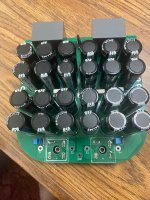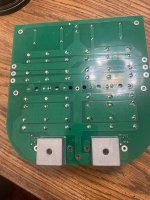for the 240/9240, I think four pairs per channel would be good. I like the IRFP140/9140 parts a bit better but the amp still sounds nice with the 240/9240.
Well, it will likely fit into a 4U 300mm with some creativity. I haven't tried that though. Also, you would be limited on the class A wattage. Class B will still go to the 100-115 watts or so.
If you want the 50w of class A, shoot for the 5U chassis. However, this depends on the speakers that you have.
If you go for the smaller chassis, you can use a 500vA transformer to save on a bit of weight and space. The constant current demands will be a lot lower and the capacitance is so large that you would be alright with the class B spikes (assuming there are any)
Mike
If you want the 50w of class A, shoot for the 5U chassis. However, this depends on the speakers that you have.
If you go for the smaller chassis, you can use a 500vA transformer to save on a bit of weight and space. The constant current demands will be a lot lower and the capacitance is so large that you would be alright with the class B spikes (assuming there are any)
Mike
When you get to biasing the amp, let me know. There are tricks to get the bias to start rising. 'It's All in my head' did a nice write up on it. I will ask if I can share it yet.
I love my F5mX! It hasn't left the rotation since building it. I was just listening to it 30 min ago.
Currently using 4 pairs of IRFP140/9140 per channel on mine. I used the big boy chassis, 5U/500 and I have +55°C temps at the top center of my sinks 🔥
Currently using 4 pairs of IRFP140/9140 per channel on mine. I used the big boy chassis, 5U/500 and I have +55°C temps at the top center of my sinks 🔥
I am really happy that you have been enjoying it 🙂 Your build is nice and tidy.I love my F5mX! It hasn't left the rotation since building it. I was just listening to it 30 min ago.
Currently using 4 pairs of IRFP140/9140 per channel on mine. I used the big boy chassis, 5U/500 and I have +55°C temps at the top center of my sinks 🔥
I've set about 0.5A bias per FET measuring around 185mV across the 0.36R resistors I used.how much bias are you running?
Unloaded rails for me are 31.7VDC on the +22VAC secondaries of the Antek. I added a request to have 22V secondaries to the order from Antek for the AN-8425, and John at Antek did his best to reduce the voltages. I may be a volt or two higher than Mike's rails just based on variation of that modification. For reference, I used 24 qty 15,000uF capacitors, instead of the 10,000uF caps in Mike's BOM. If I could do it over again, I'd probably just stick with 10,000uF caps. Since I'm using @Mark Johnson soft start (H9KPXG), I didn't use the soft start board provided with Mike's design. It seems to do just fine with the initial inrush of that massive cap bank (360,000uF!!!).
With 8 FETs per side at 0.5A and 30-ish volt loaded rails, is a lot of heat per channel (120W/channel of bias heat if I've done my math right --> Someone can correct me if I did that wrong.) My home room temp is around 72°F (22.2°C) when I'm at home and using the amp for reference. So that's just around a 35°C temp rise on the 5U/500 heat sinks to get up over 55°C. It stays under 60°C even when the room is up to 74°F (~23.5°C).
All the work to dial up the bias of the balanced amp was pretty tricky for me at first. This was my first time biasing a balanced amplifier, and I was a bit skittish with 8 different trimpots to fiddle with. I wished I had more DMM's at the time and I think I had 6 or 8 hooked up! It didn't feel like it was enough to really understand what was going on with the whole circuit. I had to trust Mike's instructions. I planned/plan on doing a write up, however, someone like Mike and Patrick (@ItsAllInMyHead ) are likely much better candidates to provide initial instructions. I'm happy to highlight the "tricky parts" that noob like me got confused with initially. Once I understood the whole process fully (took me over 8 hours to figure out with a lot of help from Mike), then it went really smoothly.
It's a really fun amp to build because of the relatively low part count, the simple and logical layout that Mike developed, and lots of help from Mike (and Patrick too!).
I couldn't be happier with the result! It's a spectacular amp to power my lower sensitivity Aerial Acoustic Model 9's (86db, 4-ish ohm). Whether at low volume or shake windows levels, it just sounds really good. "Me Likee a lot!"
Last edited by a moderator:
100%. I tried to tidy it up a little.When you get to biasing the amp, let me know. There are tricks to get the bias to start rising. 'It's All in my head' did a nice write up on it. I will ask if I can share it yet.
@uptownsquash - see attached. Suggestions are welcome and appreciated if others may want to use it.
Love this amp! 🙂
Edited to add - Since I am making some tweaks, if there is enough interest, I can try to post a quick video of the process. It's really not as complex as it may seem.
Attachments
Last edited:
I feel the need to post here again......
The F5mX continues to impress me with it's fidelity and amazing sounds. Whether I'm playing a vocal song like Sara Bareilles rendition of The Dock of the Bay, to Bob Dylan Tangled up in Blue, or electronic rock such as Daft Punk Daftendiekt and Nine Inch Nails Down In It, this amp just simply rocks it all.
I'm surprised that I've not seen more builds posted here. I haven't modified anything since my original build and I continue to be supremely impressed with my F5mX.
I have no desire to change to another amp. I'm addicted to the F5mX!!! Mike knocked it out of the park with this amp! Get to building folks....you will be rewarded with insanely good music.
The F5mX continues to impress me with it's fidelity and amazing sounds. Whether I'm playing a vocal song like Sara Bareilles rendition of The Dock of the Bay, to Bob Dylan Tangled up in Blue, or electronic rock such as Daft Punk Daftendiekt and Nine Inch Nails Down In It, this amp just simply rocks it all.
I'm surprised that I've not seen more builds posted here. I haven't modified anything since my original build and I continue to be supremely impressed with my F5mX.
I have no desire to change to another amp. I'm addicted to the F5mX!!! Mike knocked it out of the park with this amp! Get to building folks....you will be rewarded with insanely good music.
He recibido un regalo de Dan, tengo mucho que hacer, aquí en Colombia el DIY es más que un reto, ya que desde adquirir materiales hasta el cambio de moneda y la logística es toda una odisea, pero estoy feliz de empezar.
Dios te bendiga @dantwomey
Dios te bendiga @dantwomey
Hi Mike,
I built an F5M this past winter - it's been great.
Would like to scale up to the F5mX monos if you have boards left?
Thanks!
I built an F5M this past winter - it's been great.
Would like to scale up to the F5mX monos if you have boards left?
Thanks!
- Home
- Group Buys
- F5mX - A 50w bridged F5m... Sort of...

